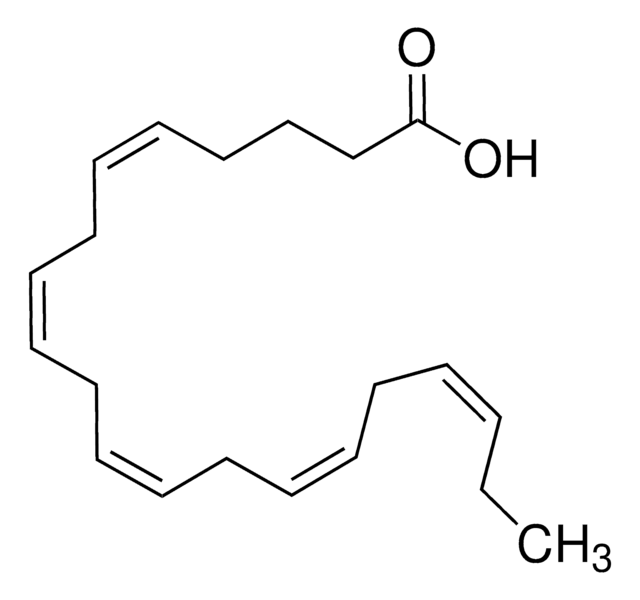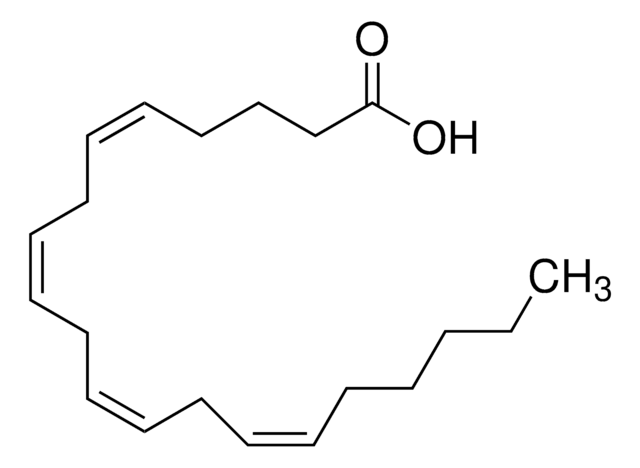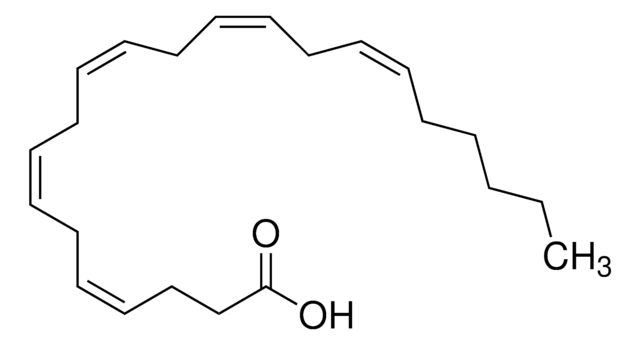Recommended Products
biological source
algae
Assay
≥98%
form
liquid
functional group
carboxylic acid
lipid type
omega FAs
shipped in
dry ice
storage temp.
−20°C
SMILES string
CC/C=C\C/C=C\C/C=C\C/C=C\C/C=C\C/C=C\CCC(O)=O
InChI
1S/C22H32O2/c1-2-3-4-5-6-7-8-9-10-11-12-13-14-15-16-17-18-19-20-21-22(23)24/h3-4,6-7,9-10,12-13,15-16,18-19H,2,5,8,11,14,17,20-21H2,1H3,(H,23,24)/b4-3-,7-6-,10-9-,13-12-,16-15-,19-18-
InChI key
MBMBGCFOFBJSGT-KUBAVDMBSA-N
Looking for similar products? Visit Product Comparison Guide
Related Categories
General description
Application
- as a component in Dulbecco′s modified Eagle medium (DMEM) for culturing cells to perform docosahexaenoic acid (DHA) treatment
- to study its impact on human induced pluripotent stem cell (iPSC)-derived neuronal at a molecular and cellular level
- in MTT [3-(4,5-dimethylthiazol-2-yl)-2,5-diphenyl tetrazolium bromide] assay to study its cytotoxic effects on three human hepatocellular carcinoma (HCC) cell lines (HepG2, Hep3B, Huh7)
Biochem/physiol Actions
Packaging
Storage Class Code
10 - Combustible liquids
WGK
WGK 3
Flash Point(F)
143.6 °F - closed cup
Flash Point(C)
62 °C - closed cup
Personal Protective Equipment
Certificates of Analysis (COA)
Search for Certificates of Analysis (COA) by entering the products Lot/Batch Number. Lot and Batch Numbers can be found on a product’s label following the words ‘Lot’ or ‘Batch’.
Already Own This Product?
Documents related to the products that you have purchased in the past have been gathered in the Document Library for your convenience.
Difficulty Finding Your Product Or Lot/Batch Number?
How to Find the Product Number
Product numbers are combined with Pack Sizes/Quantity when displayed on the website (example: T1503-25G). Please make sure you enter ONLY the product number in the Product Number field (example: T1503).
Example:
Additional examples:
705578-5MG-PW
PL860-CGA/SHF-1EA
MMYOMAG-74K-13
1000309185
enter as 1.000309185)
Having trouble? Feel free to contact Technical Service for assistance.
How to Find a Lot/Batch Number for COA
Lot and Batch Numbers can be found on a product's label following the words 'Lot' or 'Batch'.
Aldrich Products
For a lot number such as TO09019TO, enter it as 09019TO (without the first two letters 'TO').
For a lot number with a filling-code such as 05427ES-021, enter it as 05427ES (without the filling-code '-021').
For a lot number with a filling-code such as STBB0728K9, enter it as STBB0728 without the filling-code 'K9'.
Not Finding What You Are Looking For?
In some cases, a COA may not be available online. If your search was unable to find the COA you can request one.
Which document(s) contains shelf-life or expiration date information for a given product?
If available for a given product, the recommended re-test date or the expiration date can be found on the Certificate of Analysis.
How do I get lot-specific information or a Certificate of Analysis?
The lot specific COA document can be found by entering the lot number above under the "Documents" section.
Is Product D2534, cis-4,7,10,13,16,19-Docosahexaenoic acid, a solution? If so, what is the solvent? If not, what is the density?
D2534 is not a solution; it is a neat oil. The density of D2534 is approximately 0.95 g/mL.
What is the best way to prepare a solution of Product D2534, cis-4,7,10,13,16,19-Docosahexaenoic acid?
D2534 is soluble in chloroform at a concentration of 50 mg/mL. For biological or biochemical applications, chloroform is probably not suitable. Information in our files indicates that the product would be expected to be soluble in 95% ethanol to at least 10 mg/mL.
After I prepare a solution of Product D2534, cis-4,7,10,13,16,19-Docosahexaenoic acid, in ethanol, how should it be stored?
The solution in ethanol would be unstable. It is best to make solutions up fresh. If this is not possible, divide the solution into aliquots and layer argon or nitrogen over the solution in each vial. Also, the product may be packaged in ampules, or kept in a vial with a cap plug or vacuum seal and stored at -70 °C. Any antioxidant such as BHT (di-tert-butyl hydroxytoluene) will aid in preventing oxidation of this product. BHT would be one of the better antioxidants to use. It can be used at 0.1% w/w or in the most extreme cases up to 1%. The most important thing to do to prevent oxidation is to exclude oxygen from contacting the product.
I know that Product D2534, cis-4,7,10,13,16,19-Docosahexaenoic acid, is very prone to oxidation. I would like to study the oxidation in detail. Do you have any references?
A rapid method for studying the oxidation of fatty acids, including linoleic acid, eicosapentaenoic acid and docosahexaenoic acid, has been published. Boyd, L.C., et al., A rapid method for determining the oxidation of n-3 fatty acids. J. Am. Oil Chem. Soc., 69, 325-330 (1992).
Are all of the double bonds in the Product D2534, cis-4,7,10,13,16,19-Docosahexaenoic acid, in the cis-configuration?
Yes, this product's double bond configuration is cis.
How do I find price and availability?
There are several ways to find pricing and availability for our products. Once you log onto our website, you will find the price and availability displayed on the product detail page. You can contact any of our Customer Sales and Service offices to receive a quote. USA customers: 1-800-325-3010 or view local office numbers.
What is the Department of Transportation shipping information for this product?
Transportation information can be found in Section 14 of the product's (M)SDS.To access the shipping information for this material, use the link on the product detail page for the product.
My question is not addressed here, how can I contact Technical Service for assistance?
Ask a Scientist here.
Articles
The potential for the prevention and treatment of cardiovascular disease through increased dietary intake of omega-3 (w-3) fish oils is not a recent scientific discovery.
Lipid Induced Insulin Resistance
Our team of scientists has experience in all areas of research including Life Science, Material Science, Chemical Synthesis, Chromatography, Analytical and many others.
Contact Technical Service





